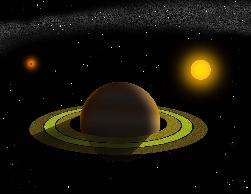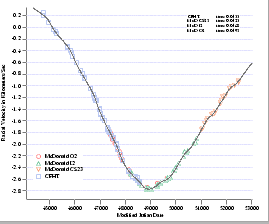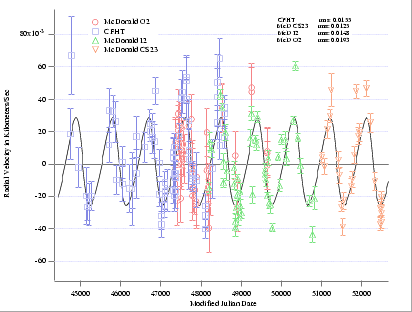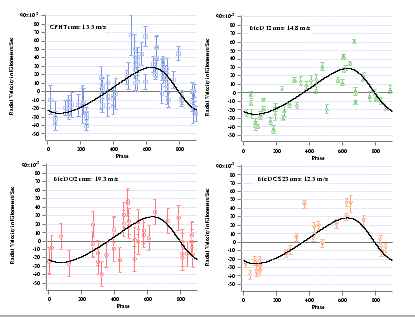A Planetary Companion to the Binary Star Gamma Cephei
A Planetary Companion to the Binary Star Gamma Cephei
Precise radial velocity measurements from McDonald Observatory establish the presence of
a planet orbiting the primary component of the gamma Cephei binary star system, as indicated
by earlier data from the CFHT (Walker et al. 1992). This companion is the first extrasolar
planet in a relatively close stellar binary system (the two stars at their closest approach
are only 12 AU apart), and thus has far-reaching implications
for our understanding how planets form in binary systems and for the overall frequency of
planetary systems in our galaxy (since the majority of stars exist in binary or multiple
systems).

Artist's conception of the planet in the gamma Cephei system (click to enlarge).
Note the two different shadows cast on the (hypothetical) rings of the planet by the light
coming from the bright primary star, the orange K1 subgiant, and the much fainter
secondary star (probably a red M-dwarf star).
Picture credit: Tim Jones/McDonald Observatory

Radial velocity measurements of gamma Cephei showing a fraction of the binary orbit and
the superimposed variation due to the planet (click to enlarge). The blue boxes are the
CFHT data, while the red, green and orange symbols show the
McDonald 2.7m-telescope results (the rms-values are given here in km/s). The McDonald
results include 3 different data sets: 1.) the McD O2: red data-points, where telluric oxygen
lines were used as the wavelength standard, 2.) McD I2: green data, a
molecular iodine vapor (I2) absorption cell delivers the reference spectrum and 3.) McD cs23:
orange data, the cross-dispersed Coude spectrometer using the same I2 cell.

Residual radial velocity variations of gamma Cephei after subtraction of the binary orbital
motion (click to enlarge). The planetary signal (solid black line) with a semi-amplitude of 26
m/s is present over 20 years consistent
in amplitude and phase. The color coding follows the same scheme as described above.

The planetary signal after subtraction of the binary orbital motion and phased to the
orbital period of 2.5 years (click to enlarge).
The planet can be seen in all four data sets (again the blue boxes are the CFHT data, while
the red, green and orange data-points are the McDonald 2.7m-telescope results). The most
recent data (cs23 spectrometer, orange data set) yields an rms-scatter of 12.5 m/s around
the planet's orbit (without the one outlier, this goes down to 9.0 m/s) and
includes observations as recent as August 2002, while the CFHT observations started in 1980!
Gamma Cephei is a K1 sub-giant in a long-period (P> 40 yrs)
binary system. Walker et al. (1992) first reported short-term
periodic radial velocity (RV) variations in the residuals
after subtracting the velocity contribution due to the
stellar companion. These residual variations had a period of
2.52 yr period and were consistent with a Jupiter-mass
companion in orbit at approximately 2 AU from the primary.
Walker et al. dismissed this hypothesis because they
detected weak variations in the Ca II emission
line index with the same period as the planet.
Precise stellar radial velocity measurements for gamma Cep
made at McDonald Observatory now extend the time baseline of
observations to more than 20 years. The combined dataset
shows that the planet period has been present and coherent
over the past 20 years. The long lived nature of the
residual RV variations make it unlikely that they are due to
stellar rotation. Our Ca II S-index measurements
show no periodic variations at the 2.5 yr period.
Furthermore, no appropriate period is found in
(contemporaneous) Hipparcos photometry.
We conclude that a planet with a projected mass of 1.76 Jupitermasses in orbit
1.8 AU from the primary star is the most likely explanation
for the short term RV variations in gamma Cep. This
planet is in a binary star system with the shortest binary
period found so far and should provide an interesting case
study for understanding how binary stars influence the
planet formation process.
Parameters of the planet and its orbit:
M sini = 1.76 M_Jupiter (minimum mass)
P = 903 +/- 6 days (orbital period)
T = 53156.85 +/- 52 days (time of periastron in Julian Date)
e = 0.2 +/- 0.07 (orbital eccentricity)
w = 76 +/- 19 deg (angle of periastron)
K = 26.3 m/s (radial velocity semi-amplitude)
Parameters of the binary:
M1 = 1.59 solar masses (assumed mass of the K1IV primary)
P = 74 +/- 16 yrs (orbital period)
T = 48506 +/- 38 days (time of periastron in Julian Date)
e = 0.44 +/- 0.06 (orbital eccentricity)
w = 162.1 +/- 1.8 (angle of periastron)
K = 1980 m/s (radial velocity semi-amplitude)
M2 sin i = 0.4 solar masses (M1V?)
a1 sin i = 4.21 AU (semimajor axis of the primary)
a2 sin i = 17.16 AU (semimajor axis of the secondary)
The Team:
Artie P. Hatzes
(TLS Tautenburg)
William D. Cochran (McDonald Observatory)
Michael Endl
(McDonald Observatory)
Diane Paulson
(University of Texas at Austin)
Gordon A.H.Walker
(University of British Columbia)
Barbara McArthur
(University of Texas at Austin)
Bruce Campbell (BTEC Enterprises Ltd.)
S. Yang (University of British Columbia)
Further links:
Abstract for the german AG meeting presentation (postscript file)
Abstract for
34th DPS meeting presentation (link to the DPS meeting website)
Gamma Cep fact sheet
(including stellar parameters from K. Fuhrmann)
Press releases:
McDonald Observatory press release (9th.Oct.2002)
AG Tagung press release (in german)
McDonald Observatory
TLS Tautenburg Observatory
References:
Walker, G.A.H., Bohlender, D.A., Walker, A.R., Irwin, A.W., Stephenson, L.S., Larson, A.,
1992, ApJ, 396, L91-94
Last update: 8th October 2002
webpage by: Michael Endl



